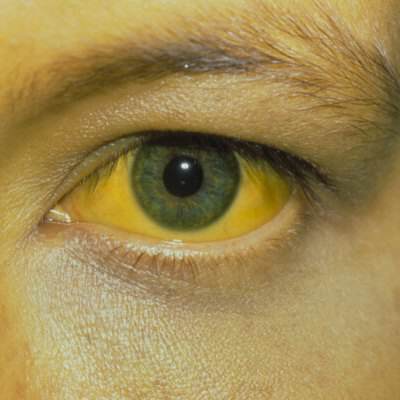Hepatitis A
- font size decrease font size increase font size
 Hepatitis is a general term meaning inflammation of the liver and can be caused by a variety of different viruses such as hepatitis A, B, C, D and E. One of the more common causes of acute hepatitis is hepatitis A virus (HAV). Hepatitis A is contracted at least 100 times more frequently than typhoid fever or cholera.
Hepatitis is a general term meaning inflammation of the liver and can be caused by a variety of different viruses such as hepatitis A, B, C, D and E. One of the more common causes of acute hepatitis is hepatitis A virus (HAV). Hepatitis A is contracted at least 100 times more frequently than typhoid fever or cholera.
But it is a self-limited disease which results in fulminant hepatitis and death in only a small proportion of patients. However, it is a significant cause of morbidity and socio-economic losses in many parts of the world. Hepatitis A was formerly called Infectious hepatitis, Epidemic hepatitis, Epidemic jaundice, Catarrhal jaundice, Type A hepatitis, HA.
CAUSATIVE AGENT
Hepatitis A is caused by infection with the hepatitis A virus (HAV), a nonenveloped, positive stranded RNA virus, first identified by electron microscopy in 1973 by Purcell, classified within the genus hepatovirus of the picornavirus family. Electron microscopy (EM) analyses show particles with icosahedral symmetry although no structural details could be discerned. Morphologically, HAV particles are indistinguishable from other picornaviruses Various genotypes of the hepatitis A virus exist; however, there appears to be only 1 serotype. HAV is resistant to: -thermal denaturation (survives at 70°C for up to 10 min) -acid treatment (pH 1 for 2 h at room temperature), 20% ether, chloroform, dichlorodifluoromethane, and trichlorotrifluoroethane - perchloracetic acid (300 mg/l for 15 min at 20°C) -detergent inactivation (survives at 37°C for 30 min in 1% SDS) -storage at –20°C for years
TRANSMISSION
typically by the faecal-oral route.But also may be transmitted: -through exposure to contaminated water, ice, or shellfish harvested from sewage-contaminated water; or from fruits, vegetables, or other foods that are eaten uncooked and that were contaminated during harvesting or subsequent handling. -Direct person-to-person spread is common under poor hygienic conditions.
SUSCEPTIBLE HOST
People who have never contracted HAV and who are not vaccinated against hepatitis A, are at risk of infection. In areas where HAV is highly endemic, most HAV infections occur during early childhood.The virus is present worldwide, and the risk of infection is inversely proportional to levels of sanitation and personal hygiene. Therefore in developing countries with poor environmental hygienic conditions, nearly all children are infected with HAV before the age of 9. There is substantial underestimation of hepatitis A cases in these areas, because HAV infections for young children are mostly asymptomatic and therefore unrecognized. As sanitation conditions improve, transmission shifts to older age groups and the incidence of symptomatic disease increases. In most developed countries, endemic HAV transmission is unlikely.
WHEN IS HAV CONTAGIOUS?
In persons who develop clinically apparent hepatitis A, secretion of virus in stool at high titres begins one to three weeks prior to onset of illness, and may continue for several weeks at lower titres after jaundice occurs. Although the level of virus shedding does not correlate with the severity of liver disease, faeces are highly infectious and therefore extremely contagious during all of this period.
EPIDEMIOLODY AND ENDEMICITY
Hepatitis A occurs sporadically and epidemically worldwide, with a tendency to cyclic recurrences. Epidemics are uncommon in developing countries where adults are generally immune. Improved sanitation and hygiene conditions in different parts of the world leave large segments of the population susceptible to infection, and outbreaks may result whenever the virus is introduced. Worldwide, HAV infections account for 1.4 million cases annually.
Geographic areas can be characterized by high, intermediate or low levels of endemicity patterns of HAV infection. The levels of endemicity correlate with hygienic and sanitary conditions of each geographic area.
High: In developing countries with very poor sanitary and hygienic conditions (parts of Africa, Asia and Central and South America), infection is usually acquired during
early childhood as an asymptomatic or mild infection. Reported disease rates in these areas are therefore low and outbreaks of disease are rare.
Intermediate: In developing countries, countries with transitional economies and some regions of industrialized countries where sanitary conditions are variable (Southern and Eastern Europe, some regions in the Middle East), children escape infection in early childhood. Paradoxically, these improved economic and sanitary conditions may lead to a higher disease incidence, as infections occur in older age groups, and reported rates of clinically evident hepatitis A are higher.
low: In developed countries (Northern and Western Europe, Japan, Australia, New Zealand, USA, Canada) with good sanitary and hygienic conditions, infection rates
are generally low. In countries with very low HAV infection rates, disease may occur among specific risk groups such as travellers.
PATHOGENESIS
Virus-induced cytopathology may not be responsible for the pathologic changes seen in HAV infection as liver disease may result primarily from immune mechanisms. Antigen-specific T-lymphocytes are responsible for the destruction of infected hepatocytes.(therefore autoimmune response)
CLINICAL PICTURE
The course of acute hepatitis A can be divided into four clinical phases:
• an incubation or preclinical period, ranging from 10 to 50 days, during which the patient remains asymptomatic despite active replication of the virus. In this phase, transmissibility is of greatestconcern.
• a prodromal or preicteric phase ranging from several days to more than a week, characterised bythe appearance of symptoms like loss of appetite, fatigue, abdominal pain, nausea and vomiting,fever, diarrhoea, dark urine and pale stools, followed by
• an icteric phase, during which jaundice develops at total bilirubin levels exceeding 20 - 40 mg/l. Patients often seek medical help at this stage of their illness. The icteric phase generally begins within 10 days of the initial symptoms. Fever usually improves after the first few days of jaundice. Viremia terminates shortly after hepatitis develops, although faeces remain infectious for another 1 -2 weeks. Extrahepatic manifestations of hepatitis A are unusual. Physical examination of the patient
by percussion can help to determine the size of the liver and possibly reveal massive necrosis. The mortality rate is low (0.2% of icteric cases) and the disease ultimately resolves. Occasionally, extensive necrosis of the liver occurs during the first 6 - 8 weeks of illness. In this case, high fever,marked abdominal pain, vomiting, jaundice and the development of hepatic encephalopathy associated with coma and seizures, are the signs of fulminant hepatitis, leading to death in 70 -90% of the patients. In these cases mortality is highly correlated with increasing age, and survival is uncommon over 50 years of age. Among patients with chronic hepatitis B or C or underlying liver disease, who are superinfected with HAV, the mortality rate increases considerably.
• a convalescent period, where resolution of the disease is slow, but patient recovery uneventful and complete. Relapsing hepatitis occurs in 3 - 20% of patients 4 to 15 weeks after the initial symptoms have resolved. Cholestatic hepatitis with high bilirubin levels persisting for months is also occasionally observed. Chronic sequelae with persistence of HAV infection for more than 12 monthsare not observed.
DIAGNOSIS
Since both clinically and biochemically, acute hepatitis due to HAV cannot be distinguished from that due to the other hepatitis viruses, serologic tests are necessary for a virus-specific diagnosis.
The specific routine diagnosis of acute hepatitis A is made by finding anti-HAV IgM (detectable about 3 weeks after exposure, its titre increases over 4 to 6 weeks, then declines to non detectable levels generally within 6 months of infection) in the serum of patients. A second option is the detection of virus and/or antigen in the faeces. epidemiologic evidence can also help in establishing a diagnosis.
At the onset of disease, the presence of IgG anti-HAV is always accompanied by the presence of IgM anti-HAV. As IgG anti-HAV persists lifelong after acute infection, detection of IgG anti-HAV alone indicates past infection. IgG provide lifelong immunity.
TREATMENT
As no specific treatment exists for hepatitis A, prevention is the most effective approach against the disease.
Therapy should be supportive and aimed at maintaining adequate nutritional balance. Alcoholic beverages should not be consumed during acute hepatitis because of the direct hepatotoxic effect of alcohol.
Adrenocortical steroids (corticosteroids) and IG are of no value in acute, uncomplicated hepatitis A, since they have no effect on the resolution of the underlying disease. Antiviral agents too have no beneficial clinical effect because a specific antiviral agent is not available and hepatic injury appears to be immuno-pathologically mediated.
PROPHYLAXIS
- Vaccine and Immune Globulin
- Boiling or cooking food and beverage items for at least 1 minute to 185° F (85° C) inactivates HAV. Foods and beverages heated to this temperature and for this length of time cannot serve as vehicles for HAV infection unless they become contaminated after heating.
- Adequate chlorination of water as recommended will inactivate HAV.
- Travelers should be advised that, to minimize their risk of hepatitis A and other enteric diseases in developing countries, they should avoid potentially contaminated water or food.
- Travelers should also be advised to avoid drinking beverages (with or without ice) of unknown purity, eating uncooked shellfish, and eating uncooked fruits or vegetables that are not peeled or prepared by the traveler personally.
